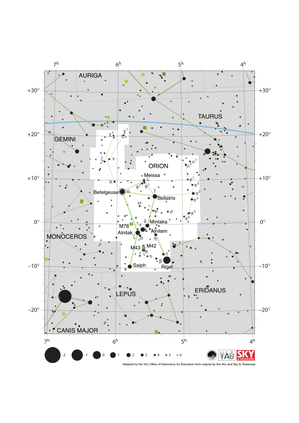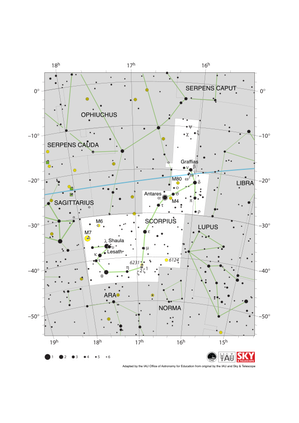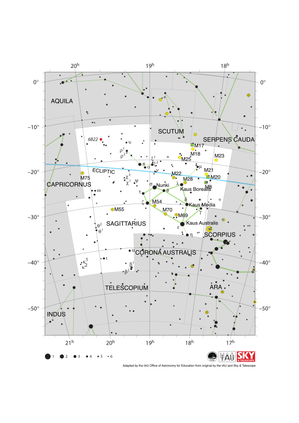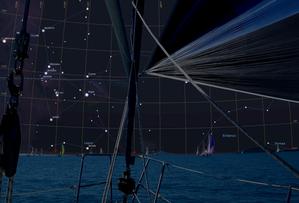Glossarbegriffe: Himmelskoordinaten
Description: Von der Erde aus nehmen wir Himmelsobjekte so wahr, als befänden sie sich auf einer Kugel, die üblicherweise Himmelskugel genannt wird. Wir können jede Position auf dieser Sphäre mit zwei Zahlen beschreiben. Jede Methode, um zwei solcher Zahlen einer Position am Himmel zuzuordnen, wird als Himmelskoordinatensystem bezeichnet. Die zwei Zahlen werden als die (Himmels-)Koordinaten des Objekts bezeichnet.
Auf der Erdoberfläche verwenden wir für den gleichen Zweck die geografische Breite und Länge. Daraus leitet sich auch eine Methode zur Definition von Himmelskoordinaten ab: Die Punkte am Himmel, die sich direkt über dem Äquator der Erde befinden, bilden den Himmelsäquator. Einem Punkt, der sich direkt über einem bestimmten Ort auf der Erdkugel befindet, werden Zahlen zugeordnet, die der geografischen Breite/Länge des Punkts auf der Erdoberfläche entsprechen.
Astronomen verwenden verschiedene Arten von Koordinatensystemen. Darunter ist auch ein System, das die tägliche Rotation der Erde berücksichtigt, sodass die Koordinaten universell sind und überall auf der Erde verwendet werden können. Dadurch wird auch sichergestellt, dass sich die Koordinaten z. B. eines Sterns über Zeiträume von Tagen, Monaten oder Jahren nicht wesentlich ändern.
Zugehörige Glossarbegriffe:
See this term in other languages
Term and definition status: The original definition of this term in English have been approved by a research astronomer and a teacher The translation of this term and its definition is still awaiting approval
The OAE Multilingual Glossary is a project of the IAU Office of Astronomy for Education (OAE) in collaboration with the IAU Office of Astronomy Outreach (OAO). The terms and definitions were chosen, written and reviewed by a collective effort from the OAE, the OAE Centers and Nodes, the OAE National Astronomy Education Coordinators (NAECs) and other volunteers. You can find a full list of credits here. All glossary terms and their definitions are released under a Creative Commons CC BY-4.0 license and should be credited to "IAU OAE".
If you notice a factual or translation error in this glossary term or definition then please get in touch.
Related Diagrams
Crux Constellation Map
Bildnachweis: Adapted by the IAU Office of Astronomy for Education from the original by IAU/Sky & Telescope.
License: CC-BY-4.0 Creative Commons Namensnennung 4.0 International (CC BY 4.0) icons
Orion Constellation Map
Bildnachweis: Adapted by the IAU Office of Astronomy for Education from the original by IAU/Sky & Telescope
License: CC-BY-4.0 Creative Commons Namensnennung 4.0 International (CC BY 4.0) icons
Libra Constellation Map
Bildnachweis: Adapted by the IAU Office of Astronomy for Education from the original by IAU/Sky & Telescope
License: CC-BY-4.0 Creative Commons Namensnennung 4.0 International (CC BY 4.0) icons
Scorpius Constellation Map
Bildnachweis: Adapted by the IAU Office of Astronomy for Education from the original by IAU/Sky & Telescope
License: CC-BY-4.0 Creative Commons Namensnennung 4.0 International (CC BY 4.0) icons
Sagittarius Constellation Map
Bildnachweis: Adapted by the IAU Office of Astronomy for Education from the original by IAU/Sky & Telescope
License: CC-BY-4.0 Creative Commons Namensnennung 4.0 International (CC BY 4.0) icons
Related Activities
Navigation in the Ancient Mediterranean and Beyond
astroEDU educational activity (links to astroEDU website) Description: Learn the ancient skill of Celestial Navigation
License: CC-BY-4.0 Creative Commons Namensnennung 4.0 International (CC BY 4.0) icons
Tags:
History
, Geography
, Celestial navigation
Age Ranges:
14-16
, 16-19
Education Level:
Middle School
, Secondary
Areas of Learning:
Discussion Groups
, Modelling
, Social Research
Costs:
Low Cost
Duration:
1 hour 30 mins
Group Size:
Group
Skills:
Analysing and interpreting data
, Asking questions
, Communicating information
, Developing and using models
, Planning and carrying out investigations
, Using mathematics and computational thinking














